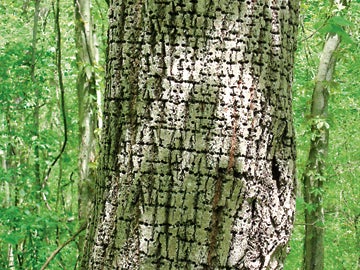Phil Hardy: A bird’s eye view — Yellow-bellied Sapsucker
Published 4:00 pm Thursday, January 28, 2016

- Sapsucker wells on a tree trunk in Ontario, Canada.
Have you ever seen a hardwood tree trunk with what looked like tiny holes drilled through the bark and into the cambium? I’m talking about a series of small holes spaced evenly, almost with robotic precision. As a child I noticed the phenomenon when I was fortunate enough to encounter it, and always wondered what caused it. I assumed that some kind of animal or insect must have caused the damage but what could it have been?
Here in Georgia the Yellow-bellied Sapsucker is the culprit and yes, there really is a bird with that unusual name. Sapsuckers are members of the woodpecker family. Since, as their name implies, they suck sap, they open tiny holes on trees known as wells with their beaks so that the tree sap can be licked by their tongue. Other species of sapsucker in North America include Williamson’s, Red-breasted and Red-naped.
As are all members of the woodpecker group, they are known as primary cavity excavators. With their chisel-like beak they open a cavity in tree trunks and utility poles for nesting and roosting. After they have finished with their nesting the cavity may serve as a nesting or roosting site for secondary cavity nesters such as Tufted Titmouse or Carolina Chickadee. The nocturnal flying squirrel also uses these holes to nest and rest in.
The Yellow-bellied Sapsucker has another important ecological role. By drilling these tiny sap wells on tree trunks, insects are attracted to the wells which in turn feed the sapsucker with a protein rich diet when they get stuck and cannot escape. Ruby-throated Hummingbirds and other bird species know this and feed at wells also. It has even been suggested that Ruby-throated Hummingbirds time their migration northward to coincide with the Sapsuckers.
Neighbors have asked me if Sapsuckers damage their trees. So I did some investigating and found that the birds will usually select weakened and/or wounded trees to drill their sap wells. Trees suffering from weakness or damage could be a result of humans, lightning, disease or insects. Apparently some trees actually die from the Sapsucker girdling the tree. Favored trees of the Yellow-bellied Sapsucker include poplar, willow, birch, maple, hickory, alder and (to a lesser degree) conifer.
Scansorial birds, like all woodpeckers and creepers, make a living climbing and clinging to trees. Sapsuckers, a shy and secretive species, have cryptic coloration that almost gives them a 3-D pattern that blends in with the tree trunk and a mixture of sunlight and shadows. Their nasal call often alerts birders to their presence.
Whenever you are out doors be on the lookout for sap wells on tree trunks. Add in lots of patience and luck and you just might get a glimpse of the Yellow-bellied Sapsucker this winter.
Phil Hardy, a bird watcher and bird photographer, lives in Americus.


